Running the New York City Marathon (2003)
![]()
"Few things in life match the thrill of a marathon." -- Fred Lebow
In sports medicine, I have what are known as "fast twitch" muscles. That is, my body is designed to deliver short, explosive, powerful bursts of physical energy (which explains why I was a sprinter and jumper in high school track & field). My muscles quickly scream in agony any time they are asked to work for more than minutes. So what business would I have in deciding to tackle an activity that requires the long, patient endurance necessary to run 26.2 miles-an activity best suited to "slow twitch" bodies?
Indeed, the longest distance my legs had previously allowed me to run was less than 10 miles.
As I trained over the spring, summer and fall before the NYC marathon, I asked myself this question over and over again. Why, indeed?
Best I can come up with as an answer is this: as with the madness that came over me nearly 10 years ago when I took the BIG plunge and tried sky-diving, I observed my significant other do something and thought to myself: "Dammit, if she can do it, so can I!!!"
In this case, my wife Maureen had run the 2001 Marine Corps Marathon in DC while I watched from the sidelines.
It only took Maureen a tiny amount of prodding to convince me to train with her to run New York City. As a marathon virgin, however, I quietly sublimated my fear. How could I POSSIBLY run over 26 miles-a run that would last over four continuous hours???? Have I lost my mind??
But like a man, I courageously swallow my fears and plunged ahead into training-training made much easier by the fact that Maureen is joining me in the hard work.
Looking back now, the training regimen seems insane. Sunday through Thursday, we would arise at 5 or 5:30 in the morning to begin preparing for the daily run. And in the Florida summers, when most of our training took place, this means waking up to hot, muggy conditions even before the sun rises. We'd run 3 to 6 miles on those days, with only Mondays off, coming home each time literally drenched in sweat. "If sweating is good for you," I tell Maureen after a particularly hot day of training, "I'm going to be the healthiest guy in town."
The training program makes me aware of one of the few benefits I'm able to identify with regard to a years-long problem I'm having now with insomnia. Since I have been unable to sleep past 3 or 4 a.m. for a number of years, I have no problem getting up in time for my pre-sunrise jaunts.
My only consolation in these days of misery is to relish the thought of running in the much cooler and drier air of New York in November.
But the days of Florida training are a comparative walk in the woods compared to the dread we face on Saturdays each week. On that day, our schedule tells us we must run progressively long runs. First 10, then 12, then 16, and eventually 21 miles in the weeks leading up to the big day in the City.
On several of those Saturdays, I would set personal records for the longest distance I have ever run.
Each time I succeed in doing it, my confidence builds.
Stretching becomes essential. Maureen saves me from ending up in a wheelchair by bringing home one day a Runners World video that demonstrates a "breakthrough" muscle stretching routine for runners. The breakthrough "isolates and activates" our muscles. We follow the video 2 or 3 times each day, which still leaves my "abductor" muscles in my inner thighs very tight and sore, but at least I am able to run. Without the stretching, I am unable to even walk or stand. The pain is that excruciatingly fierce.
We soon become so familiar with the words spoken by the instructors in the video that we begin imitating their words and voices in our sleep and while we run. The bizarre aspect of the video is this: One of the instructors used to work in an office next to mine 10 or 15 years ago, as he was formerly a city planner like myself in Gainesville. I have not seen him since he left that job back then, but always noticed that he was heavily involved in running activities. Little did I know that he would one day pop up on my TV screen, instructing me how to "isolate and activate" my aching muscles.
Despite the regular stretching, I soon start taking Maureen's advice by gobbling 2 to 5 ibuprofen pills each day to control the pain. This for someone who has never taken ibuprofen in his life.
Another lifesaver during my training is our backyard Jacuzzi. Luxuriating in that spa on the Saturdays after one of the long runs becomes one of the most joyous, relieving feelings I've ever experienced.
A friend recommends that I read "Anti-Oxidant Revolution" by Kenneth Cooper. In it, he cautions against "overtraining" because of the heavy free radical load delivered to one's body as a result of such strenuous activity. Cooper makes note of studies showing that such exercise and the excessive free radicals that might be released unchecked can lead to a number of health problems, such as an increased likelihood of cancer, heart disease, premature aging and other assorted assaults on the body. Cooper concludes by recommending that if a person chooses to engage in high-intensity activity regardless of such risks, that an "anti-oxidant cocktail" of Vitamin C, E and beta carotene be consumed regularly.
Given the above, my daily regimen becomes three daily doses of ibuprofen, two to four daily stretching episodes, and two daily doses of Vitamin C and E.
It is not only the tight, sore muscles that brings suffering. I also develop regularly appearing large, ugly blisters on my heels and toes over the first few weeks (although the heel abrasion is due not to running, but walking several miles at a DC conference in the middle of my training with shoes not yet broken in). The result of all of this punishment of my feet is that I spend a good many days at my office walking around in my socks, since it was too painful to wear my office shoes. In addition, training runs are more gingerly, and I have to fight the temptation to "favor" one leg or foot over the other (a "no no" when training, since favoring can lead to additional injuries).
Hydration during training is essential. Each of the routes we select for a run is required to have a "water stop" every 3-4 miles. We stumble, out of breath, into convenience stores to drink from a water fountain at 7 a.m. Often, the only water available, though, is from a dirty, grimy garden hose at a gas station, or a rusty hose bib on the side of a building.
My runs are assisted, at first, by being in the spring months. It is cool enough for us to take along my puppy dog on a leash (Kona Bona Bologna). He very happily runs with us, as he greedily engages in sniffing and peeing fests. The assistance is that he is so eager to run to his next sniff that he pulls me along with his leash, which leads us to conclude that he must be a husky mix-breed who was hard-wired to be pulling dogsleds.
Sadly, Maureen needs to drop out of training for the marathon in late summer due to a leg injury she suffers. Its heartbreaking for her, as she has worked so hard up to that point to prepare for the marathon.
One important benefit of my training is this: I soon lose 25 pounds as I become noticeably trim and toned. The joy is that such weight loss occurs even though I follow an additional training recommendation of eating enormous amounts of food-particularly carbohydrate-rich pastas and breads. No need to watch what you eat while marathon training. Eat promiscuously and without guilt at the dinner table and at parties. The troubling question, however, is whether one can manage to return to normal consumption levels after the marathon...
Beginning one month out from zero hour, I begin to feel a gathering, unstoppable momentum. I am on a runaway horse galloping toward New York City, only a few weeks away, and there is no backing out now. Already, my adrenalin is pumping. Am I really going to go through with this?
By Week 14, I am able to discontinue my daily consumption of ibuprofen pills because the pain in my legs has greatly subsided. I am unable to conclude, however, whether the eased pain is due to my body adjusting to the rigors of the training, or if the anti-oxidant Vitamin E and C I've recently started taking in larger quantities is responsible. Another possibility: I am now enjoying running in noticeably cooler fall weather-an exhilarating, invigorating experience after so many months of punishing heat and humidity.
In my final week of preparation, I sit down to add up all the miles I have run since February to train for the marathon-those nonstop weeks of endlessly pounding pavement. I am stunned to find that over the 9 months of running, and including the marathon itself, I will have run approximately 760 miles.
Which is the equivalent of running from my home in Gainesville, Florida to St. Louis Missouri.
Had someone told me back in February that I'd be running such a cumulative distance over the next 9 months, I'd have concluded that such a feat was impossible, and promptly given up on my quest to run a marathon.
But here I am, healthy and in one piece after running incessantly from Florida to Missouri.
My wife and I board a plane on a Friday morning for The Big City. We arrive early enough for an afternoon of sightseeing and trying (unsuccessfully) not to walk too far on Friday and Saturday before the Sunday run (it is of the utmost importance that a marathon runner rest and "carbo-load" in the few days before the run).
But the City is so full of excitement that we are unable to stay in our room and relax.
We visit the spectacle known as Time Square-a dazzling, Vegas-like place full of bright lights, dramatically striking billboards, towering skyscrapers, and honking horns (one street sign we see warns that a honking horn leads to a $165 fine, which is no surprise given the epidemic of blaring car horns in the city). We also are immersed in the bustle of street performances and tourists in the Square. Unfortunately, we do not manage to stumble across the infamous "naked cowboy," who strums his guitar on a sidewalk in the Square each day wearing a cowboy hat, boots, underwear and nothing else.
After the square, we visit Grand Central Station. I am awed by the glorious, soaring, magnificent character of the architecture inside Grand Central. Equally impressive is our next destination-the New York Public Library in Manhattan. I was especially struck by the stupendous woodwork inside the library, and the domed ceilings (faintly reminiscent of the Sistine Chapel).
A short walk takes us to Rockefeller Center, where we stop and watch the ice skaters.
We make an obligatory visit to "Ground Zero," the now vacant, cavernous void that was recently home of the gargantuan symbols of American economic power-the World Trade Center Towers. It is an eerie sight, as we imagine what once stood here and is now vaporized. The site is largely cleaned up, but clean-up crews continue to busily work, and spectators continue to somberly take in the sobering view.
On our first night, we reverse roles by becoming spectators to an extremely bizarre scene. We witness a seemingly endless Halloween parade watched by tens of thousands. Given the already peculiar nature of New York City residents, we were treated to some quite outstanding, outrageous costumes. For hours, we watch what seems like a parade joined by everyone living within 30 blocks of the parade route. Perhaps the most amusing duo was a pair dressed as George Bush and Saddam Hussein. "George" is chasing after "Saddam," who is carrying a box labeled "Weapons of Mass Destruction." Occasionally, they stop to put up their dukes and spar with each other. We also note, disturbingly, that a great many of the paraders are dressed up as Roy from Sigfield & Roy, with a white tiger latched on to Roy's neck (Roy has recently been mauled by one of his tigers in a show). Is tragedy the mother of comedy?
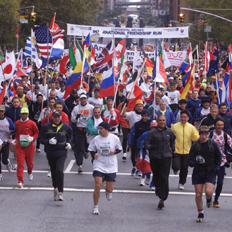
On the day before the race, the annual warm-up 4-mile "International Friendship Run" is held from the UN Plaza (photo at left). Gathered here are runners from throughout the world, proudly displaying the flag of their country. The camaraderie is pleasant and spirits are high. The event provides the amusing spectacle of attempting to communicate to people speaking so many different languages. Each time instructions or announcements were made from the podium, it had to be repeated in what seemed like 38 different languages. It therefore took approximately 20 minutes to issue two-sentence comments with the microphone.
The night before the race, we take the subway to meet friends from Gainesville in New York's Little Italy-home of a large collection of outstanding, authentic Italian restaurants. We are assured by our Gainesville friends beforehand that we will enjoy a truly authentic restaurant. Sure enough, we are taken to "La Mela," perhaps the most memorable and enjoyable dining experience I've ever had.
The restaurant is jammed to the gills. It is filled with happy, loud, laughing, festive, gregarious people-perhaps made so by the delicious food and the infectious nature of everyone having a good time.
Guests here do not order from a menu. Instead, you are served the Italian feast of the day. First, an enormous platter of anti-pasta was brought to our table of eight. After we had finished with the platter, we are brought a platter of three types of fresh, homemade pastas (one of which was my lifelong favorite: gnocchi's). I have three large helpings of the carbo-loading pasta in anticipation of the next day. Maureen tells me that friends at the table are STILL talking about how much food I ate.
After the pasta, we are brought a platter of three meats. Finally, our culinary orgy is completed with a platter of sumptuous deserts.
Magnifico! Bene! Bene!
The last time I was in New York City was 25 years ago while in high school. At the time, I had no knowledge of urban design, and was therefore unable to appreciate the splendor of the City.
My impressions of the New York City subway system, however, are grim. In comparison to the superb Metro system serving DC, the NYC system is dark, dirty, grimy, claustrophobic, scary and depressing. To add insult to injury, our tempers flare as we find that the map of routes and the directional signs are clear as mud. Several times, we find ourselves heading in the wrong direction, even after getting attendant directions and using the subway for most of a day. Upon learning that the subway has seen dramatic improvements in recent years, we are appalled to contemplate what it formerly was.
On the morning of the race, November 2, 2003, a friend and I walk from our Park Central Hotel in Manhattan to the New York Public Library at 5:30 a.m. I am stunned to see several blocks of large buses lined up bumper-to-bumper in two rows, waiting to board the runners heading to Staten Island and Verazano-Narrows Bridge, where the race will start. This year, the 34th annual, there are 34,662 runners. It is the largest number ever for this marathon.
Our bus is unloaded near the bridge, and we are marched to a grassy area next to the bridge. I have the feeling that I am an astronaut being led to the launch pad for a NASA space launch. And in a way, it is exactly that. The distance we runners are to travel is unimaginably long.
From the time we arrive at the staging area near the starting line at 6 a.m. until 9:30 a.m., there is a continuous stream of buses taking the tens of thousands of runners to the grassy field we have settled into as we impatiently wait for the 10 a.m. starting time.
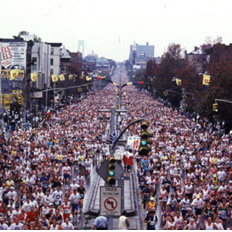
While waiting, we "hydrate," stretch, and try to keep our muscles warm (Fortunately, NYC experiences an Indian Summer of record warm temperatures this year. I am told by another runner that last years' marathon served up the misery of 32 degrees and drizzle.) A problem with hydration is the frequent need to urinate, and this is a marathon that provides appreciated assistance to men, for the staging area has was is purported to be the "world's largest urinal"-fashioned out of PVC.
I lubricate my feet and toes with Vaseline, and apply something I had never used or seen before: a "Breathe Right" nasal strip on my nose. ANYTHING to help my lungs get more oxygen over those looming 26.2 miles!
Finally, at 10:20 a.m., we are herded toward the Verazano-Narrows Bridge starting line. But again we wait. Clothes keeping the runners warm during the wait are being tossed from the waiting area. Suddenly, the earth quakes as an extremely loud, booming cannon signals the beginning of the race.
We are off!
The great mass of runners begins an ascent of the Bridge as Frank Sinatra's "New York, New York" plays from the loudspeakers. There are so many thousands of us jammed on the bridge that I must slow below my normal running pace. I glance down at my watch and realize I am behind my 4-hour pace and must wait for an opportunity to gain back those lost minutes.
Off the bridge a few miles into the race, we enter into New York City neighborhoods, where the 2.5 million spectators cram in along the route. They cheer with gusto and creativity and enthusiasm. It is a thrilling experience to be a runner in the midst of such exciting, excited support from the on-lookers.
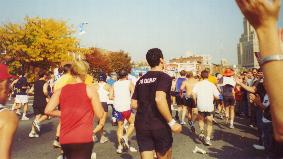
The cheering picks up my spirits and energy level. I'm now running with confidence, strength, and a smile on my face. Within a few miles, I've regained my lost time on the bridge.
The front of my shirt reads "Run Dom Run" and the back "Go Dom Go." As a result, large numbers of spectators are yelling for me, by name, to run. I raise my fist in appreciative acknowledgement. (I'm the naively happy guy at left with the black shirt and shorts)
The route takes us through the five boroughs-Staten Island, Brooklyn, Queens, Bronx, and Manhattan. Many of the neighborhoods are extremely attractive, cozy, vibrant, and obviously authentic. The residents seem proud of their neighborhoods, as one street sign reads that one is now leaving the Borough of Queens. I begin to think about the pleasures of living in such a walkable, friendly, character-rich setting.
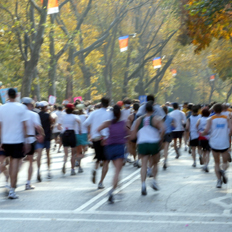
There are an enormous number of signs being held by spectators along the street curb urging runners on. My favorite reads "4 hours = sex," in reference to the amount of time expected to run the 26.2 miles by the boyfriend or husband of the woman holding the sign. What an incentive!
Along the route, runners find 35 bands playing music (a welcome sound, as we soon learn that each band is playing at a mile marker, meaning that we are approaching the next mileage milestone). Also at each mile, we find large tables with volunteers lined up to hand out cups of spring water and Gatorade.
A good percentage of signs are cheering on the famous rapper, "P. Diddy," who is running the marathon as a fund-raiser. I come upon him at about mile 14. He is accompanied by a motorcycle escort. Spectators cheer wildly as he passes. A large number of young children run out onto the course to run alongside of him. This leads them to get in my way, and I find I must aggressively pull them out of my way to run by them and their hero (a police officer in the vicinity was largely being ignored in his crowd control efforts).
Despite the frantic scene accompanying P. Diddy, I am able to pass him by and achieve at least one victory in my run. I eventually reach the finish line well ahead of Mr. Diddy. "Yo momma!"

By mile 20, I am beginning to find out what it means when people say you "hit the wall at mile 18." In part, I am now paying for those early miles, when I picked up my pace (and squandered precious stores of energy) to regain lost time on the Verazano-Narrows Bridge. My legs are like lead weights. My feet ache. I no longer have the energy to acknowledge spectators who are encouraging me to run(that's me at right, in a state of complete exhaustion). I've run out of gas. I start resigning myself to the fact that I will not be able to finish the race. Each mile now feels like it is 100 miles long. But I MUST KEEP RUNNING!! How embarrassing, after all, for Maureen and my friends to see me walking-giving up-near the end of the race. My sense of pride will carry me through, even if I don't have an ounce of energy left.
At mile 24, the route starts providing large, colored banners over the course announcing the mile marker. People watching are holding signs assuring runners that "you are almost there!" "Keep running!" With one mile left, we see bold signs assuring us that the finish line is 800 meters...400 meters...200 meters...
But despite these encouraging signs, the finish STILL seems like an impossible distance away. Somehow, though, I keep my legs moving in a positive direction. By now, I am running deliriously. I am incoherent. Unable to recognize Maureen even if she jumped out in front of me on the route.
I look down at my watch. I AM VERY CLOSE TO MY 4-HOUR GOAL FOR THE RACE!!!!!!!!!!!!!! CAN I DO IT??????????
I muster all of my remaining reserves. I bear down to find a final kick.
I shock myself by crossing the finish line (see below).

My final time: 4 hours, zero minutes...and 53 seconds!!!!!!!!!!
Must I run AGAIN since I was so close to my goal??????
No. I refuse to give in to the urge. I'm satisfied with what I have somehow managed to do. This will be my first and last marathon.
At the finish line, runners are quickly handed "Heat Sheets" to retain body heat (photo below left). Proudly, we bow our heads to receive a large, heavy, metallic medallion to wear around our necks.
I am proud to say that I am the 8,676th runner to cross the finish line (raising my fists triumphantly as I cross...), which places me within the top 25 percent of the 35,000 runners. And for my age group, I am the 1,400th runner to cross.
The pain I feel at the end of the run was fierce. Today, as I write this a few days later, the pain is only intolerable. Just stepping over a street curb is an enormously torturous experience. I could barely walk the few blocks to the hotel, and have a desperate need to sit down and rest. But after running over 26 miles, muscles painfully freeze up, which means that stopping to sit is not allowed.
For 20 minutes, I am hyperventilating, and incoherent.
But the pain is overshadowed by the pride I feel in my accomplishment today. I am humbled by the many residents of the city who approach me as I walk back to our hotel and offer their congratulations when they see my medal.
How exhausting is the NYC Marathon? Three years after I run it, in a Gainesville [FL] newspaper article dated 1/3/07, the legendary bicyclist Lance Armstrong proclaimed that the New York Marathon was the hardest physical thing he'd ever done.
Some amazing factoids about this 34th Annual NYC Marathon:
First year of the NYC Marathon = 1970
Number of runners in 1970 = 127
Number of runners in 2003 = 34,662 (largest number ever for this marathon)
Number of applicants in 2003 = over 70,000
Course record = 2 hours, 7 minutes (Tesfaye Jifar, 2001)
Wheelchair course record = 1 hour, 38 minutes (Krige Schabort, 2002)
Number of international participants = 10,000
Oldest male entrant = 93 years old
Oldest female entrant = 86 years old
Race day volunteers = 12,000
Spectators along route = 2.5 million
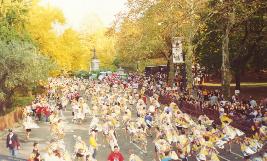
Television viewers = 224 million in 125 countries (carried by NBC in the US)
Gatorade along course = 309,000 cups
Spring water along course = 1.6 million cups
Ice along course = 17,160 pounds
Medical aid stations on course = 25
Tylenol tablets along course = over 10,000
Perhaps the most incredible feat I heard about runners at the event was a small group of runners who, by running the NYC Marathon, ran 7 marathons in 7 days in 7 countries.
On November 3rd, I made my first appearance in the New York Times—albeit modestly. My name was among the list of the sub-five hour finishers in the special Marathon section of the Times that day.
An unforgettable weekend.
I WANT TO BE A PART OF IT, NEW YORK, NEW YORK!!!!!!!!!!!
Back to Dom's Voyages and Adventures page.